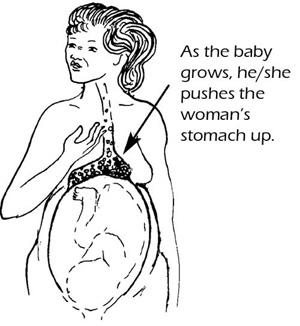Changes in the gastrointestinal system in pregnancy
As you may remember from your high school biology, food and fluids enter the gastrointestinal system in the mouth, pass through the oesophagus, stomach and intestines, and solid waste exits at the anus. This very long tube from mouth to anus is often called the 'gut'. Proteins, fats and carbohydrates in our diet are broken down (digested) in the gut into units small enough to be absorbed from the intestines into nearby blood vessels. It is also the route by which nutritious substances, such as vitamins and minerals, enter the body.
During pregnancy, the muscles in the walls of the gastrointestinal system relax slightly, and the rate at which food is squeezed out of the stomach and along the intestines is slowed down.
Can you think of a reason why slowing down the passage of food through the gastrointestinal system might be beneficial in pregnancy?
It increases the time available for digestion, and it maximises the absorption of nutrients from the diet.
Undesirable effects also result from slow emptying of the stomach, and slow movement of food through the gut.
Can you suggest one of these undesirable effects?
Many pregnant women experience constipation (difficulty in passing stools).

Many women also have nausea in the first months of pregnancy. A burning feeling, or pain in the stomach or between the breasts, is called indigestion (or 'heartburn', although the heart is not involved). It happens because as the pregnancy progresses, the growing baby crowds the mother's stomach and pushes it higher than usual (Figure 7.3). The acids in the mother's stomach that help digest food are pushed up into her chest, where they cause a burning feeling. This is not dangerous and usually goes away after the birth.
If the mother has difficulty with nausea or indigestion, advise her to eat small, frequent meals. The mother should not lie down flat for 1 to 2 hours after eating, because this may cause these symptoms. In Study Session 12 you will learn more about minor disorders of pregnancy such as these, and how to help the woman manage them.